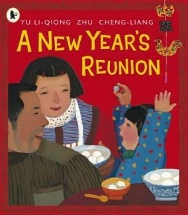A New Year's reunion by Yu Li-Qiong

Ill. by Zhu Cheng-Liang. Walker Books, 2012. ISBN 9781 4063 3857 7.
(Age: 5+) Highly recommended. Picture book. New Year. Taiwan.
Family. Multiculturalism. First published in Taiwan in 2008, this
absolutely charming story offers much more than a tale of father's
homecoming for the New Year. We are simply told that he works away,
helping to build houses in faraway places, as the family prepares
for his return. In the notes at the end of the book, we read that he
is one of the 100 million migrant workers employed in China each
year, given a few days off at New Year to return to his family. When
he comes home the family is happy and joyous, He gives them presents
and then has his beard shaved off to become the father the little
girl, Maomao, remembers. Together the trio make sticky rice balls
for New Year, with Daddy inserting a lucky coin into one. Whoever
retrieves the fortune coin receives good luck. Maomao is the lucky
one, but during the day while visiting friends for New Year, she
loses the coin. A resolution of her loss is paralleled with the loss
of her father as he returns to work in the new year.
I found myself reading and rereading this story as I found more and
more about the lifestyles and customs of Taiwanese people about whom
I knew little. Not only is there a range of things presented in the
text, but the illustrations reflect the lives of these people as
well. The background to each page draws the eye to the abundance of
customs, festivities, clothing, food, housing and activities. I was
totally fascinated by the colour and life of the drawings, and the
book is now by my bed as I reread it. The Chinese dragon snakes its
way across two pages as the family visits their friends, rugged up
in their new padded coats against the very cold weather. The family
makes sticky rice balls to eat, and later walk through the streets
with distinctive housing. The whole will not only add considerably
to any child's understanding of how families celebrate New Year
elsewhere, but also how families operate and work together. Few
children here would only see their fathers once a year, and yet in
this story, both children do just that. It is not only a salutary
read but one that adds considerably to our knowledge of a country
within our region.
Fran Knight